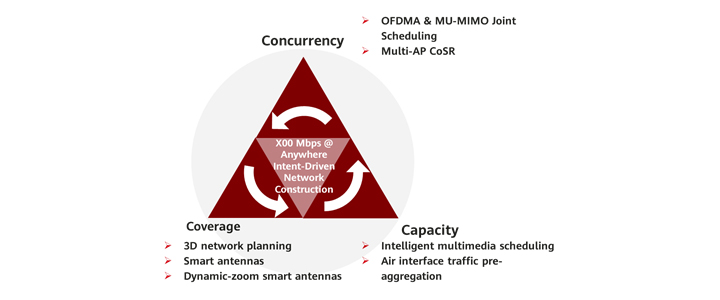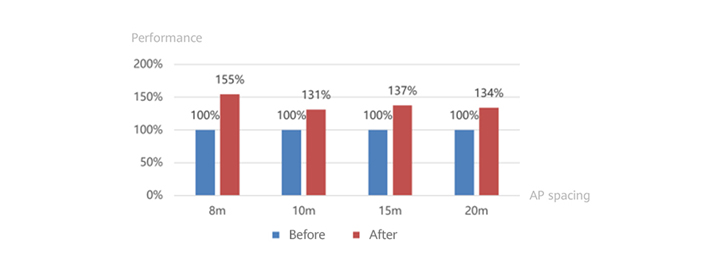This site uses cookies. By continuing to browse the site you are agreeing to our use of cookies. Read our privacy policy>
![]()
This site uses cookies. By continuing to browse the site you are agreeing to our use of cookies. Read our privacy policy>
![]()
Enterprise products, solutions & services
At HUAWEI CONNECT 2022, Huawei's data communication product line released the experience-centric "X00 Mbps @ Anywhere" wireless network construction standard to simplify planning, acceptance, and optimization, which are typically challenging for wireless networks due to lack of a quantifiable construction standards. This new standard helps to deliver "200 Mbps @ Anywhere" fully-wireless office network experiences.
The advancement of Wi-Fi 6 greatly enhances the capability of a single Wi-Fi AP, allowing APs to gradually permeate many industries, such as enterprise offices, schools, hospitals, hotels, airports, factories, warehouses, stadiums, and more. Free from wired access restrictions, wireless access terminals can move freely. However, air interface contention and interference are difficult to mitigate, leading to various issues. For example, the negotiated rate of a STA gets lower as it moves further from the associated AP, the AP throughput deteriorates as more STAs access the AP, the average performance of a single STA becomes poorer when the concurrent STAs increase, and the strong air interface interference can severely impact performance and user experience. Therefore, in addition to the factors of wired network construction, wireless coverage, concurrency, and capacity must also be considered for wireless network construction.
Against this backdrop, Huawei proposes the "X00 Mbps @ Anywhere" experience-centric wireless network construction standard, which defines two indicators — experience rate and service experience — as well as two goals: acceptable network construction capability and assured service experience. "X00 Mbps" indicates that the single-user experience rate can reach X00 Mbps. Additionally, indicators are quantified based on different scenarios:
|
Scenario |
Experience Rate |
Service Experience |
|
Enterprise office |
200 Mbps per user |
60-channel video conferencing without frame freezing when there is 50 Mbps background traffic |
|
Smart classroom |
200 Mbps per user |
48-channel VR/AR without frame freezing (40 Mbps per terminal) |
If Wi-Fi is upgraded to Wi-Fi 7, the experience rate in office scenarios can reach 500 Mbps per user, and the service experience can 150-channel video conferencing without frame freezing when there is 200 Mbps background traffic.

Figure 1: Indicators and goals
To consolidate the wireless network construction standard, Huawei has made multiple technological innovations to improve coverage, concurrency, capacity, and intent-driven network construction.

Figure 2: Technological innovations for X00 Mbps @ Anywhere
Exclusive 3D WLAN network planning and AI-based real-time network simulation enable wireless signals to reach every corner. Huawei's online 3D network planning tool can automatically read the floor plan of the onsite environment and flexibly define partition types of multiple materials. In addition, the tool can automatically recommend appropriate AP models based on scenarios and use built-in professional simulation algorithms to implement high-precision signal coverage simulation and even intuitive roaming experience. In this way, the professional network planning work is handed over to the intelligent system.
APs have up to 16 built-in smart antennas. With the exclusive beamforming algorithm, the smart antennas emit stronger and more focused signals, providing 20% larger coverage radius than traditional antennas. With smart antennas, the signal strength at the same location is doubled, providing pervasive wireless coverage for users.
The next-generation Dynamic-Zoom Smart Antennas support the omnidirectional and high-density coverage modes. By intelligently detecting the terminal density in the access environment, Dynamic-Zoom Smart Antennas flexibly switch between the two coverage modes, perfectly adapting to the coverage requirements of tidal access. In wide coverage scenarios, the antennas switch to the omnidirectional mode. When the user density increases, the antennas automatically switch to the high-density mode. In combination with the smart antenna training algorithm and high-performance reflector technology, the AP reduces interference at the signal edge and improves performance by more than 20%.

Figure 3: Performance changes before and after the coverage mode of Dynamic-Zoom Smart Antennas is switched (data source: Huawei lab test report)
The unique OFDMA & MU-MIMO joint scheduling improves concurrency performance by 35%. Conventionally, OFDMA and MU-MIMO technologies are used in high-density scenarios where multiple terminals perform concurrent services. With OFDMA, in the same timeslot of a single spatial stream (carrier), different resource units (RUs) (subchannels) can be used to transmit data of different users. In other words, one channel is used to implement simultaneous transmission for multiple users, which is applicable to small-bandwidth applications. The other technology, MU-MIMO, enables an AP to connect to different users through multiple spatial streams and send data to different users simultaneously, making it applicable to large-bandwidth applications. Technically, OFDMA and MU-MIMO do not conflict with each other and can be both deployed. However, due to complex algorithms, other solutions in the industry cannot use both of these two technologies at the same time. Huawei AirEngine Wi-Fi 6 overcomes this using innovative software and hardware technologies and optimized algorithms, implementing OFDMA & MU-MIMO joint scheduling. Multiple concurrent spatial streams are supported, and multiple services can be performed on each spatial stream. This improves channel efficiency, reduces latency, and greatly improves the overall capacity and user experience.
Huawei applies the innovative multi-AP CoSR technology defined in the Wi-Fi 7 standard to Wi-Fi 6 APs, aiming to reduce co-channel interference in high-density scenarios and improve concurrency performance. Through coordination between the sharing and shared APs, the sharing AP accurately controls the transmit power for each packet of the shared AP, eliminating co-channel interference from the shared AP to the sharing AP and improving network-wide concurrency performance by 20%.
Intelligent multimedia scheduling achieves no rate limiting on the entire network, unleashing 100% of the AP capacity. Working in a similar way to flexible network slicing, intelligent multimedia scheduling analyzes KPIs (such as the delay of multimedia services) in real time based on the big data application identification results. When the quality of key services is poor, the algorithm dynamically suppresses greedy services to ensure multimedia service experience. When the user experience is good, user services are not affected and the network bandwidth is fully utilized to eliminate the need of rate limiting configuration on the entire network. According to statistics, the algorithm reduces the maximum delay of audio and video services by 57% and the average delay by 66%, without compromising the quality of audio or video services.
Air interface traffic pre-aggregation reduces air interface conflicts and improves single-user capacity. Compared with traditional air interface preemption and transmitting packets one at a time, air interface traffic pre-aggregation aggregates multiple packets or traffic flows before sending them. In addition, different pre-aggregation and scheduling policies are used for different types of services. This feature improves the PPDU aggregation rate, single-frame capacity, and MU scheduling success rate while ensuring normal service running. It also reduces the number of air interface fragments, air interface conflicts, and air interface contentions, increasing the single-user capacity by 30%.
Based on AI algorithms and big data learning and analysis, scenario self-optimization forms a network baseline to implement intent-based self-optimization and configuration of Wi-Fi experience parameters, ensuring wireless network experience. AI capabilities are leveraged to analyze network data based on reported data, and KPI data (such as the service rate and delay) is displayed in real time, achieving experience visualization. Meanwhile, the scenario-based KPI or KQI baseline is formed based on network data. In this manner, customers are provided with different scenarios based on their intents to automatically optimize experience parameters such as radios and loads.
Huawei's AI-powered intelligent radio calibration improves the network-wide performance by 50%. This technology can analyze data from up to seven dimensions, training and learning historical data sets on the network. During training, different weights are assigned to data at different time periods. This enables an AP to accurately predict the service load and channel conflict, and even identify the impact of special installation environments. In this way, the optimal channel, bandwidth, and transmit power can be customized for each AP to meet customers' service requirements. According to statistics, this algorithm can improve the network-wide performance by 50% and reduce the channel interference rate by 49%.
Based on these optimizations, Huawei implements the "200 Mbps @ Anywhere" wireless network construction standard of Wi-Fi 6. Currently, these technologies have been fully verified on Huawei's tens of thousands of office networks to build ubiquitous wireless networks with 100 Mbps to 200 Mbps experience. The wireless networks ensure mobile office and collaborative innovation anytime, anywhere for 180,000 Huawei employees in more than 1000 office areas, improving office efficiency by 40%.
Disclaimer: The views and opinions expressed in this article are those of the author and do not necessarily reflect the official policy, position, products, and technologies of Huawei Technologies Co., Ltd. If you need to learn more about the products and technologies of Huawei Technologies Co., Ltd., please visit our website at e.huawei.com or contact us.